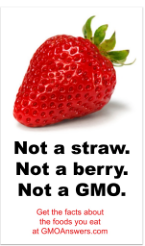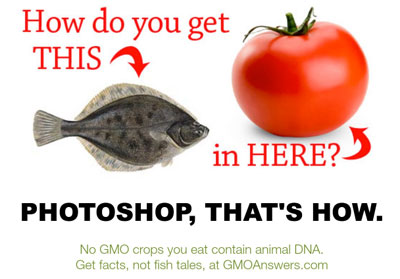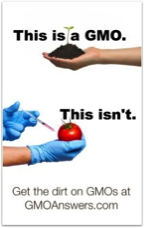Question
why is GMO so bad
Submitted by: ashy
Answer
Expert response from Community Manager
Moderator for GMOAnswers.com
Monday, 25/04/2016 13:26
A lot of misinformation exists in our society today surrounding GMOs. GMO crops have been grown for more than 20 years, but we haven’t done a good job communicating about them – what they are, how they are created and why they are used. So, we understand consumers have questions about GMOs and biotechnology and may think they are “bad,” that’s why we created GMO Answers – to dispel many of the myths and misinformation which has spread online about GMOs and provide the facts. We hope you’ll explore the facts and make up your own mind about GMOs.
Here we’ll provide many of the common reasons GMOs are often cited as “bad” online and in the media, and then provide you with the facts about each of those claims.
Listed below are some of the most common claims and misconceptions surrounding GMOs. Read the full article here.
If it’s extra-large, seedless, looks weird, tastes bad, and feels squishy – it must be a GMO.
There’s a lot of confusion out there about what is a GMO and what isn’t. Just because a strawberry is extra-large and shaped kind of funny, that doesn’t mean it’s a GMO.

When people refer to genetically modified organisms (GMOs), they are referring to crops developed with genetic engineering. Okay, then what’s genetic engineering? It is a breeding technique which enables plant breeders to take individual traits from one plant or organism and transfer them to the plant that they want to improve. It can also be used to make a change to an existing trait in a plant. For more on this, check out this post on what a GMO is and isn’t.
GMOs aren’t safe and they’re only tested by the companies making them.
You may have heard the rumors that GMOs cause cancer, autism, allergies, gluten intolerance, or other illnesses and conditions in humans and animals. While this makes for catchy headlines, it is simply not true.
GMOs are the most regulated and tested product in agricultural history. Click here to find hundreds of independent studies, which you can also search for on Biofortified.org. Additionally, many independent scientists and organizations around the world – such as the U.S. National Academy of Sciences, United Nations Food and Agriculture Organization, World Health Organization, American Medical Association and the American Association for Advancement of Science – have looked at thousands of scientific studies and concluded that GM food crops do not pose more risks to people, animals or the environment than any other foods.
Before they reach the market, crops from GM seeds are studied extensively to make sure they are safe for people, animals and the environment. GMOs take years, and millions of dollars, to come to market. Click here to find out how much time, money and research goes into every GMO you eat before you ever see it.
Did you know, that some GM plants, like Golden Rice, Vitamin A and iron-enriched bananas, and nutritionally improved cassava, can actually benefit human health. In fact, GM crops might be able to prevent or reduce allergies in the future. For example, a GM peanut could help to alleviate peanut allergies.
For more information, check out these presentations from Dr. Karl Haro von Mogel from the University of Wisconsin, Madison on potential future GM crops, and Dr. Bruce Chassy from the University of Illinois at Urbana Champaign on the risks, benefits and safety of GM crops.
There is animal DNA in GMOs.
Once upon a time there was an experimental tomato that contained a gene from the winter flounder to increase the tomato's resistance to frost, but that tomato was never commercialized. While that tomato did not survive, its legend continues to live on in online search engines. While there are many fake images online featuring fishy tomatoes, there are, in fact, no GMO tomatoes commercially available today. Further, there are no commercial GM crops on the market today that are genetically modified to contain “animal genes.”

It’s important to note that an estimated 60 percent of the genes in plants have very similar copies in animals. While DNA isn’t specifically pulled from a fish and combined with a plant, DNA from any source is made up of the same four basic nucleotidebuilding blocks: adenine (A), cytosine (C), thymine (T), and guanine (G). DNA that comes from a plant or a microbe has the same four nucleotides as the DNA in animals.
Get more information on this misconception, including links to articles on the subject, here.
GMOs have pesticides injected into them.
Some GMO crops are genetically engineered to fight off pests…but if you search online, you will usually be led to believe that this happens by using a syringe to inject pesticides directly into a plant, most commonly the syringe injecting a tomato. (There are no genetically engineered tomatoes.) However, some crops, like corn and cotton, have been genetically engineered to resist pests, reducing damage to these crops and the need for as many pesticide applications. These seeds contain a protein from Bacillus thuringiensis (Bt), a common soil bacterium, allowing them to resist very specific pests. The Bt protein is only toxic to certain types of insects that feed on the plants, like the European Corn Borer. Bt is not toxic to humans, other mammals or other insects. In fact, Bt has been used for more than 100 years in organic farming as a pesticide spray.

Learn more about how Bt crops work in this post by Andrew Kniss, Associate Professor of Weed Ecology & Management, Department of Plant Sciences at the University of Wyoming on GMO Answers, and this post by University of California, Berkeley biologist Michael Eisen. Get more information on naturally occurring pesticides here.
Looking for more?
In this answer, we explore many of the potential benefits of GMOs. Our “mythbuster” series debunks many of the common myths related to GMOs. Check out our resources and other information on this topic here.
Looking for expert perspectives?
Mary Mertz, a Kansas farmer, answered a similar question, addressing how there is a “public-image problem” with GMOs and how misinformation is circulated to consumers. She states:
“GMOs have a public-image problem. The science-based reality proving GMOs to be safe and nutritious takes a backseat to the emotional propaganda meant to create skepticism in the mind of the consumer.
The National Academy of Sciences, the World Health Organization, the American Medical Association, the American Dietetic Association, and the American Association for the Advancement of Science, among many other reputable institutes and organizations, find GMOs to be as safe and nutritious as foods produced in any other way.”
Robert Wager, Vancouver Island University faculty member, explains the real criticisms of GM crops including the high costs of GM seeds, regulatory costs, germline biodiversity, cross pollination, fertilizer use and herbicide-resistant weeds.
“GM crops are relatively new to agriculture but have been widely adopted by farmers around the world. In fact, the developing world now grows more acres of GM crops than the developed world. But, as with all technologies, there is significant room for improving how these crops are used in the future. The world will have 9-10 billion people by midcentury, and therefore we will need the best of every agricultural technology (both old and new) to help to produce more food on the same or less land more sustainably. GM crops are only part of the solution.”
You can find more information about GM foods and the arguments around how they are described in similar responses here, here and here.